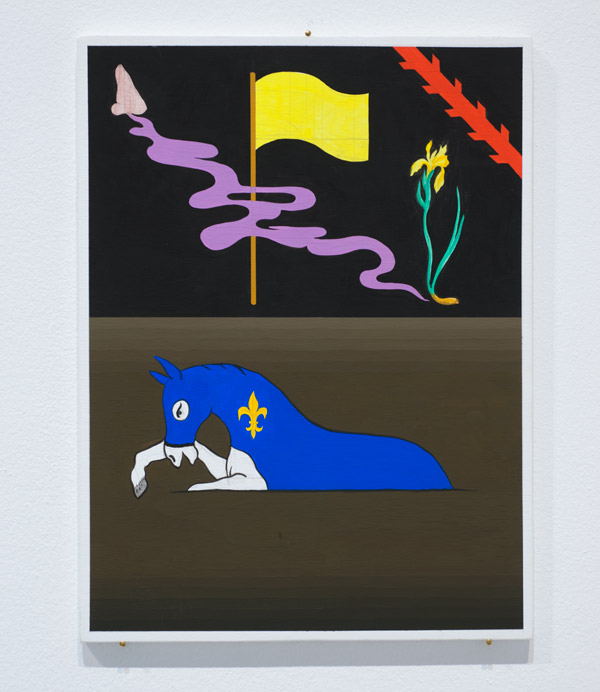Kasper Bosmans
Gladstone Gallery, Brussels, Belgium
Gladstone Gallery, Brussels, Belgium

‘Legend: Model Garden’ (all works 2016), a series of six small gouache paintings on panel, can be read as a key to the surrounding sculptural pieces in ‘Model Garden’, Kasper Bosmans’ first show at Gladstone Gallery in Brussels. Referring to them as ‘legend paintings,’ Bosmans has repeatedly returned to this type of work throughout his relatively nascent career. Each features appropriated symbols, heraldic motifs, pictorial codes and historical signs, which reveal a number of real historical events. In ‘Model Garden’ the paintings refer to objects planted in the gallery’s enfilade which harbour stories of ecology, migration and exclusion that specifically relate to Brussels, where Bosmans is currently based.

On one of the outer right panels of ‘Legend: Model Garden’, for example, a yellow iris (also known as yellow flag, a flower that once thrived in the marshlands surrounding Brussels) floats against a blue backdrop, which in turn refers to the flag of the Brussels-Capital Region. Another panel unpacks the ambiguous origin myth of this symbol: a horse wearing a blue caparison is shown sinking into the ground (recalling the legend of the Duke of Brabant who lured French knights into the marshes, while his own cavalry escaped through a path of iris flowers) and the yellow flag in the right upper corner of the painting is reprised by a large silk banner of the same colour hanging from a piece of wood (Iris Pseudacorus [Yellow Flag]). Historical references join contemporary issues: combining native and exotic plants (the flag was dyed with turmeric on one side and sap from the plant chelidonium on the other), the work complicates botanical identification and assumptions around what is native and foreign.

Though Bosmans’ stylized paintings render the surrounding objects more legible, they are not always necessary. In the centre of the first room, Pillars of Hercules II – Ceuta & Gibraltar comprises two fallen boxes adorned with the present day flags of Ceuta and Gibraltar – the cities on opposing sides of the Strait of Gibraltar known as the Pillars of Hercules in antiquity. This is a rather literal allusion to Brussels’ strict immigration policy, which also acts to note the historical contingency of cultural symbols. Hanging from a thin string in the second room, Cow + Krampus (2016) is a bell referring to the one used by Krampus, a horned demon in Alpine folklore who, in contrast to Saint Nicholas, actively punishes any naughty children at Christmas. The bell is used in annual ceremonies when men dress up as Krampus in cow-and horsehair costumes in order to scare small children. These associations with childhood fears also make the bell a potent symbol of transition to adulthood and of abandoned beliefs. Here it perhaps acts as a reminder of the disillusioned and disenfranchised youth of Brussels’ Islamic communities.

Despite Bosmans’ use of symbolism, the work is not simply didactic. By using ciphers to stand in for distinct contexts and time periods, he acknowledges just how slippery language and narrative can be, and how overloaded schemata can become. It requires a particular sort of ingenuity to assemble such obscure references in order to rework and repurpose them for the present political concerns. Moreover, in a post-truth era where pronouncements have become ornamental rather than rooted in reality, Bosmans’s insistence on the malleability of historical fact feels oddly timely.
Main image: Kasper Bosmans, Cow + Krampus, 2016, bell purchased on krampusimperium.at, synthetic string. Courtesy: Gladstone Gallery, New York / Brussels © the artist; photograph: Philippe de Gobert





















